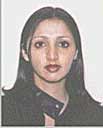|
|
For my Ph.D. thesis I am working in the Ukrainian team of the ALICE Collaboration of the future LHC at CERN. I have worked on the methods developing for the double- sided microstrip detectors (DSMD) characteristic measurements. In this investigations the suitability of the detector to the ALICE experiment requirements has been analysed and the data for required detector spectral quality has been obtained. Now I am working on the methods and electronics set up developments for preliminary and for full testing of the DSMD characteristics on the stage of the detector modules preparations. This includes design and development of the special test stations, of the microstrip detector test modules, readout electronics control system, monitoring software and data analysis system. |
Farahnaaz NAUYOCK
University of Manchester, Department of Physics and Astronom
farah@hep.man.ac.uk

|
For my Ph.D, I am working on the ATLAS LHC project. In the past, I concentrated more on working on the hardware, more specifically testing the radiation hardness of the components of NMR probes because these probes need to withstand ten years of running at the LHC. I also did some simulation work on the magnetic field of the solenoid of the ATLAS Inner Detector. The main aim was to find how fast the magnetic field can be generated. I am currently working on the elastic WW scattering at the LHC and doing the analysis using Atlfast, a C++ Object Orientated implimentation of a Atlas fast simulation package. |
|
|
The CMS Detector is one of the four experiments currently under construction at the future LHC collider site at CERN, Geneva. Its silicon strip tracker will consist of nearly 16.000 detector modules operated at a temperature of -20 degrees celsius. In order to investigate the electrical behaviour of the modules under CMS-like conditions, I am performing tests on the first prototypes, including strip intercalibration measurements, measurements of the effects of thermal cycling on the readout, and module quality tests with laser illumination and particle irradiation. Furthermore, I am investigating the performance of the cooling mechanism for the tracker end cap modules.
|


